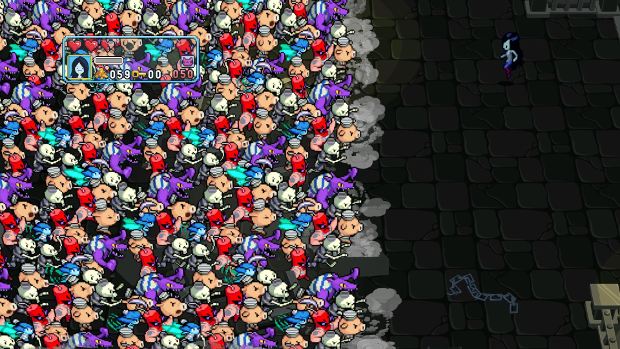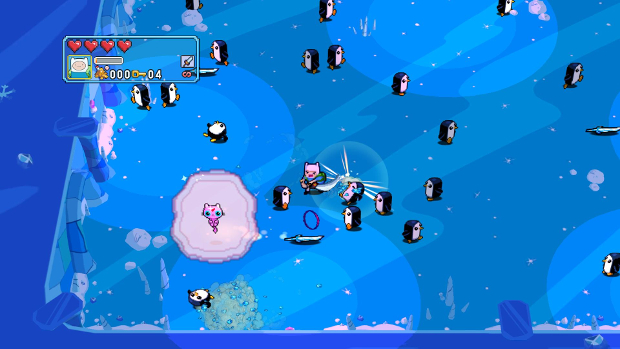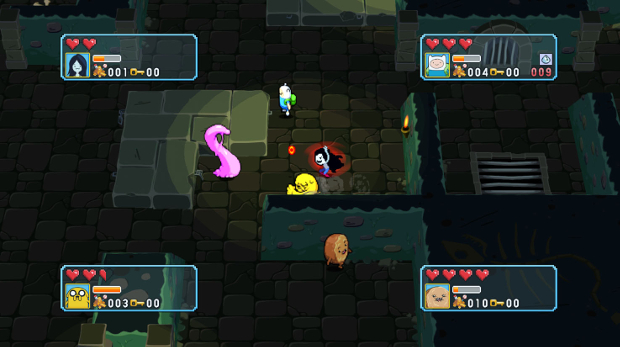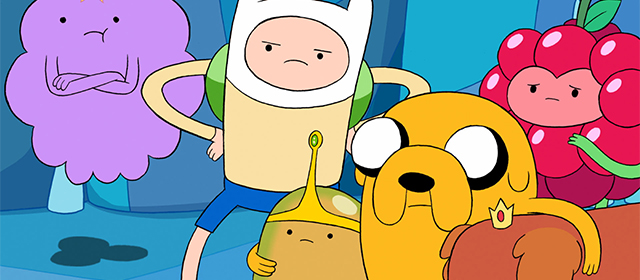Despite only being shown on the Cartoon Network channel, Adventure Time is fast becoming one of the biggest cult animated hits in recent memory. This series of short, ten-minute episodes has captured the hearts of many a child and adult that has enjoyed its blend of childlike humour, surreal characters and strange storylines. It also leans heavily on fantasy RPG themes, and its soundtrack is almost entirely made of chiptunes. As a result, Adventure Time is prime fodder for a video game adaptation, one that goes beyond the typical licensed shovelware that comes from a cartoon.
So how the hell have WayForward taken a gloriously surreal and imaginative cartoon, and made it into a game that is so utterly monotonous and devoid of any sort of fun?

It all starts so well, too, with an intro that wouldn’t look out of place in a NES-era Konami game. Adventure Time’s main protagonists, Jake (the dog) and Finn (the human) are summoned to the Candy Kingdom by the Bubblegum Princess (bear with me here). The Princess’s woes revolve around the dungeon where she keeps the many foes that Finn and Jake have apprehended on their adventures – more specifically, the duo have done such a good job at being awesome heroes, there are simply too many criminals locked away in the dungeons. To stop the prisoners escaping, Finn & Jake must explore all 100 floors of the dungeon in order to save the day.
In a dungeon-crawler that’s more Gauntlet than Diablo, the aim is to find the stairs on each level that lead to the next floor, smacking enemies and collecting treasures as you go. Every five floors, you are given the opportunity to leave the dungeon and go up to the surface, to spend your riches and take quests from the strange citizens of the Candy Kingdom, some of whom will allow you to upgrade your stats for a fee. Sadly, these upgrades are far too expensive to purchase, especially as once you re-enter the dungeon, you lose all your treasure because of what the game calls “Candy Tax”. The only way you’ll likely to be able to afford even the simplest of upgrades is to wait until later levels.

When in the dungeon itself, you’ll probably see most of what the game has to offer on the very first floor. There’ll be plenty of enemies, and objects that spawn more enemies until you destroy them, and you’ll quickly realise that there is little to no point in killing them, as you’ll rarely get any worthwhile items from them. You’re far better off just looking for the exit straight away while collecting as much treasure as you can. Unfortunately, each floor is so uniformly designed, you’ll get lost because every inch of every level looks pretty much the same. In fact, you’ll play through 20 floors before you’re even taken to a different environment, and when the game does finally take you somewhere else, you’ll face mostly the same enemies but reskinned, with levels similarly structured to the 20 you just played.
So let’s recap: You’ll be playing a game where you have to play 100 floors of dungeon crawling in almost identical areas, fighting almost identical enemies, most of which aren’t worth attacking because there isn’t even some sort of experience system to make it worth your while. Oh, and watch out for the many lengthy loading screens inbetween floors that are either too long, or freeze the game entirely. Does that sound fun to you?
You can have up to four people playing the game, each controlling their favourite character, each one with different stats, abilities, and a special Imagination move that will either attack enemies or aid you and your fellow players. Part of me thought that maybe this game might be enjoyable with other players – but how wrong I was. It still feels like a dull, repetitive game, only this time I was playing with other people that got bored after the first level.

The one thing that WayForward get right is the presentation. While the mundane environments are rendered with polygons, everything else is drawn in 16-bit sprites, which works well with the subject matter. Cutscenes are also drawn in this style, but are fully voiced by all of the show’s talent, and written by the same team as the show as well. It’s as authentic as you can get, and even the audio sounds like it came from a mid-90’s SNES title. I can’t fault the game for its bright and colourful presentation, which only serves to make me feel more angered by the actual game itself.
VERDICT: What went wrong with here? The source material is perfect for an RPG or dungeon crawler, and the basic gameplay would have been fine if WayForward has put some imagination into the environments, combat, enemies, level structure, abilities, etc. The authenticity to the series shown in the cutscenes and the general presentation would be enough to make an average game a little more attractive to fans – but, sadly, this is way below an average game.

BAD. Ugly, lazy, and unpleasant, if we’ve scored a game so low then it has serious issues. A 3/10 game will suffer from a combination of uninspired, lacklustre design, unfixed bugs and poor presentation.
Review copy provided by the publisher.



-1-1-85x85.jpg)


